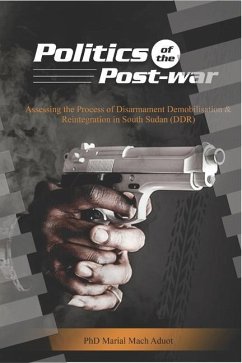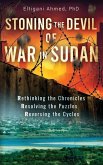The Disarmament, Demobilisation and Reintegration (DDR) of ex-combatants is a critical aspect of conflict prevention in countries emerging from civil war. It is often designed and implemented in post-war situations to contribute to broader national recovery efforts through Security Sector Reform (SSR), primarily to support the twin objectives of 'sustainable peace' and 'development'. The justification for the DDR was based on the perception that 'peace requires breaking the command-and-control structures operating over rebel fighters... thus making it more difficult for them to return to organised rebellion' (Spear, 2002, p. 141). Following the ending of the war between the Sudanese's Government and the Southern rebels - the Sudan People's Liberation Movement/Army (SPLM/A) in 2005 (Rolandsen, 2011), the security arrangements mandated the implementation of a DDR. According to the peace accord, the main antagonists, the Sudan Armed Forces (SAF) and the SPLM/A should demobilise a substantial number of their forces. The accord envisaged the DDR in South Sudan as a provisional security measure to facilitate the fundamental challenge of proportional downsizing of force, rationalisation and standardisation of ex-guerrilla forces into a national army. During implementation, the DDR in South Sudan fell short of meeting its envisaged objectives. This failure formed the basis of this project's research question: What are the factors affecting the DDR in South Sudan? The main challenge cited by this project is the conflict's context in Sudan. The war between military Islamists in the North and the radical secessionists in the South created a political situation characterised by conflicting security and political demands, which sought a military strategic balancing and conflict manipulation. In the post-war South/ern Sudan, the effort to conduct the DDR was met with hostile socio-political conditions based on an attempt to maintain the status-quo of a united Sudan versus partitionist demands. This contradiction caused a tense post-war transition, a situation 'best described as a no peace-no war environment (Munive, 2013, p. 586). Despite the importance attributed to DDR in the Comprehensive Peace Agreement, the unwillingness by the SPLM/A to downsize its force, and the perils of designing and applying such a complicated process, failed the initial CPA-DDR. The SPLM/A was extremely hesitant or unwilling to downsize its forces 'due to a perception that the CPA was merely a ceasefire with the North' (Munive, 2013, p. 586). In South Sudan, however, the internal outlooks were not supportive of the DDR. The devastating civil war resulted in a humanitarian catastrophe that claimed the lives of millions and drove more away from their homes between 1983-2005. Since then, South Sudan has been undergoing a process of violence and security configurations between the different ethno-political groups. This condition makes it difficult for the Southern Sudanese to maintain the requirements for the DDR, especially the capacity to reintegrate the demobilised ex-combatants. Thus, this thesis identifies various socio-political and economic factors affecting the process of DDR in South Sudan. One of the main issues emphasised is that South Sudan emerged from war too fragile and fragmented along ethno-political lines. In this challenging situation, the DDR confronts debilitating problems. This lack of capacity means the South Sudanese state cannot meet certain functions that require centralised use of force. The main emphasis is that South Sudan emerged from war to peace, from rebellion to government, and from contested territory to statehood, in quick transition. This region has been without government or supreme authority for a long time and hence developed alternative governments. This fragmentation of authorities allowed multiple armed structures to emerge, with intersecting influences on the use of force.








